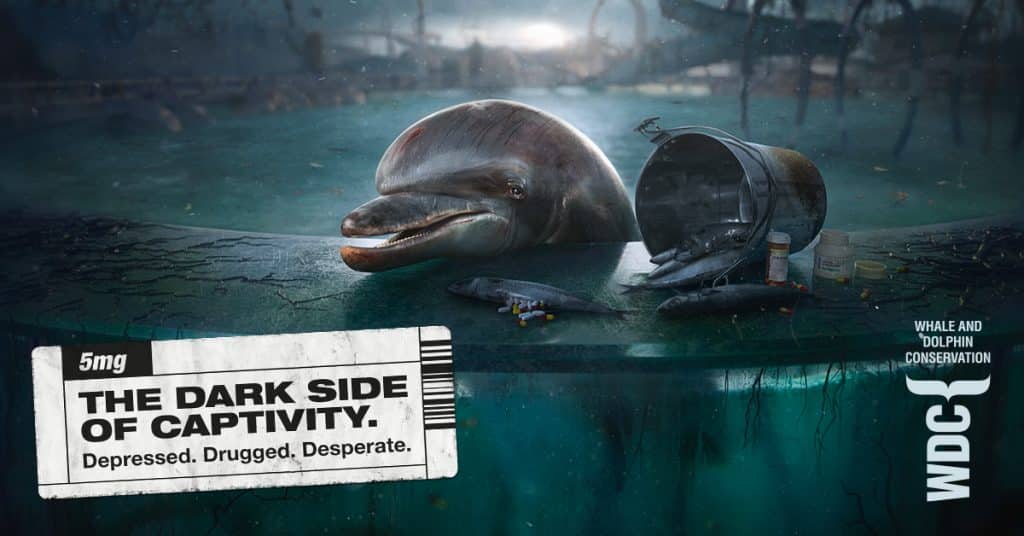In June 2025, a dolphin calf named Gemma was born at Discovery Cove in Orlando. While the park framed her birth as something to celebrate, animal welfare advocates know the truth: this is not a triumph—it is a tragedy. Gemma’s birth represents yet another life condemned to the confines of a tank, far from the open ocean where dolphins are meant to live and thrive.
Her story is not unique. Dolphins born into captivity face a lifetime of deprivation, stress, and health risks. They will never know the freedom of the wild, never swim vast distances, and never live within the rich social networks of their natural pods. Instead, their lives unfold inside concrete tanks—commodities in an industry built on profit and spectacle.
Life Without the Ocean: The Physical and Psychological Toll
Unlike wild dolphins, captive-born calves like Gemma will never experience the sea. They cannot learn essential survival skills such as hunting for fish, avoiding predators, or navigating long distances in complex marine ecosystems. Instead, their environment is artificially designed, stripped of stimulation, and often too small for natural movement.
The consequences are severe:
- Chronic stress and boredom: Confinement leads to unnatural, repetitive behaviors such as swimming in tight circles, rubbing against tank walls, or floating listlessly at the surface. Some dolphins even chew on gates and tank linings in frustration.
- Aggression: Frustration and lack of space often cause heightened aggression between dolphins, sometimes resulting in injuries.
- High mortality rates: Captive dolphin calves face disturbingly high rates of neonatal death. At Brookfield Zoo, a calf born in June 2025 survived only four days—tragic but sadly common in captivity.
- Food deprivation training: Even dolphins born in tanks are subjected to training methods that rely on withholding food until they perform human-directed tricks. This practice creates further stress and undermines their natural behaviors.
What may appear to visitors as “happy dolphins” performing acrobatics is, in reality, a survival mechanism under duress.
The Myth of Conservation
One of the most persistent justifications for dolphin breeding programs is conservation. However, experts and animal protection organizations have repeatedly exposed this claim as misleading.
- Bottlenose dolphins are not endangered. They are bred in captivity not to support conservation but to replace aging animals in marine parks and continue the entertainment pipeline.
- No reintroduction to the wild: Dolphins born in captivity, like Gemma, cannot be released into the ocean. Lacking survival skills, they would not be able to hunt or protect themselves. Their entire lives, from birth to death, are predetermined within the walls of an enclosure.
- Exploitation disguised as education: While facilities argue that dolphin shows inspire public awareness, research shows they perpetuate myths rather than instill true conservation values. The so-called “dolphin smile” is not happiness—it’s a fixed facial feature exploited to mislead audiences.
The conservation narrative is, at its core, a marketing tool to justify a practice that has nothing to do with protecting wild populations.
Ethical Responsibility: A Call for Change
As science continues to reveal the depth of dolphin intelligence and their intricate social bonds, the ethical implications of captivity become impossible to ignore. Dolphins are self-aware, emotionally complex beings with needs that no tank can meet.
To continue breeding them for entertainment is, as critics argue, not just outdated but morally indefensible. Every ticket purchased to parks like Discovery Cove sustains an industry that profits from animal suffering.
The responsibility now falls on us—consumers, policymakers, and communities—to recognize the truth and demand an end to captive dolphin breeding.
Climate, Conservation, and the Bigger Picture
The plight of dolphins in captivity is deeply tied to broader issues of climate and conservation ethics. While oceans warm, ecosystems collapse, and wild dolphin populations face mounting threats, corporations continue to profit from artificial breeding programs that do nothing to address real-world crises.
By supporting true conservation—protecting wild habitats, reducing pollution, and confronting the climate crisis—we can redirect resources away from entertainment-based exploitation toward meaningful environmental stewardship. Learn more about the urgent need for climate action and its role in wildlife protection at Sustainable Action Now’s climate section.
A Future Without Captive Births
Baby Gemma’s life is a symbol of what must change. Instead of celebrating captive births, we should see them for what they are: a reminder that exploitation continues despite growing awareness of its cruelty.
Ending dolphin captivity will require bold steps:
- Phasing out breeding programs at marine parks.
- Investing in seaside sanctuaries where dolphins already in captivity can live more natural, enriched lives.
- Redirecting public support from dolphin shows to true conservation efforts in the wild.
- Educating the public about the reality behind the “dolphin smile.”
Only then will we move toward a future where dolphins are no longer born into lives of confinement but instead protected in the wild where they belong.
Gemma’s birth may be framed as a joyous event by Discovery Cove, but it is, in reality, another tragedy for dolphins in captivity. Deprived of the ocean, subjected to stress and exploitation, and denied the possibility of a natural life, she represents the very reason the captive dolphin industry must end.
The world has reached a point where our understanding of animal intelligence and our moral responsibilities can no longer be ignored. True progress means fighting for a future where dolphins are celebrated in the wild—not trapped behind glass.


